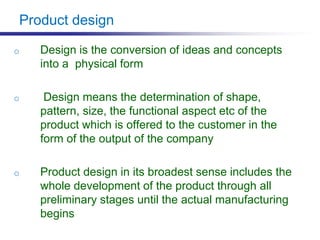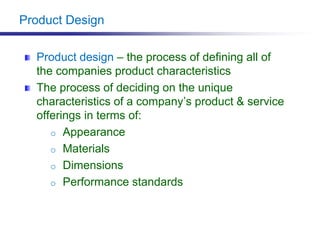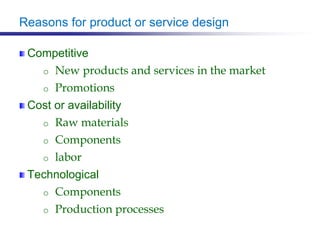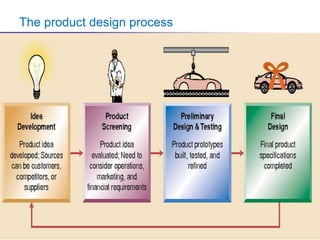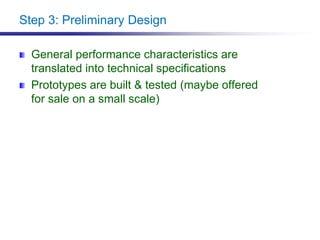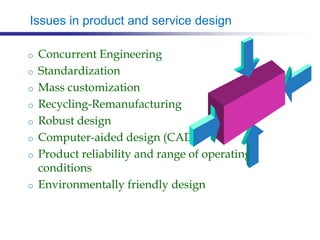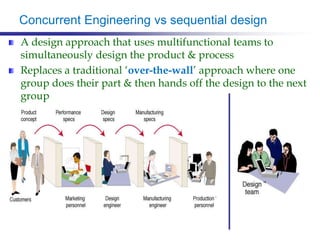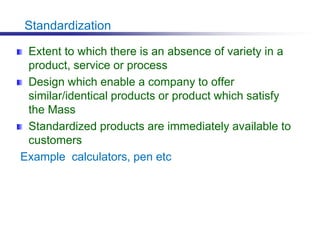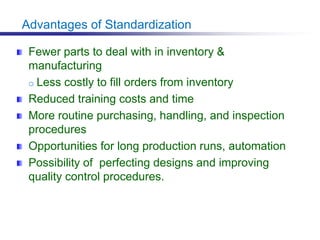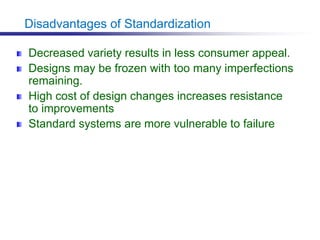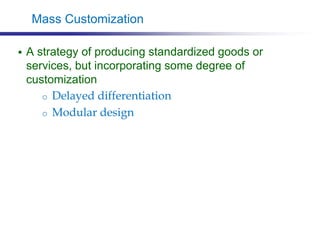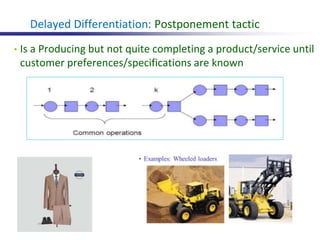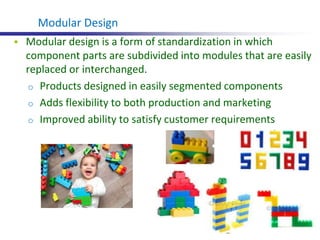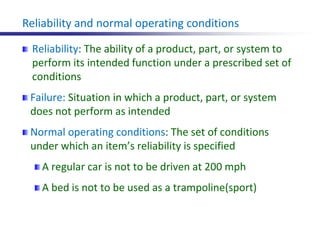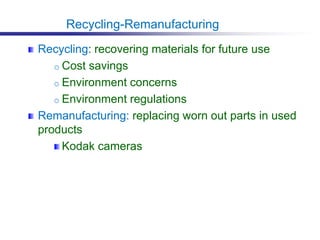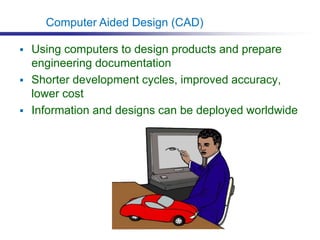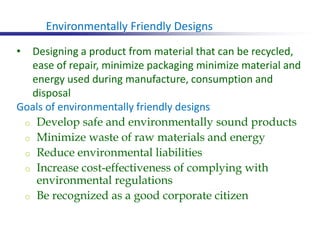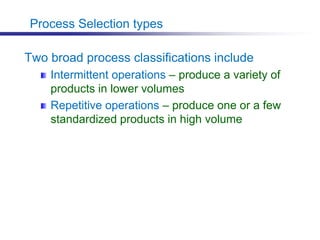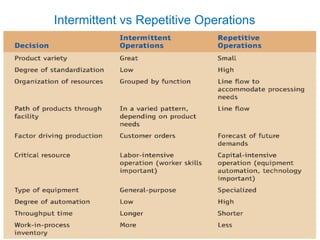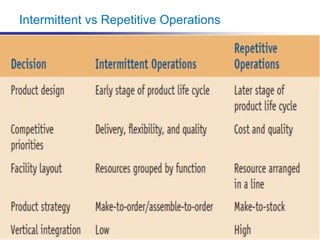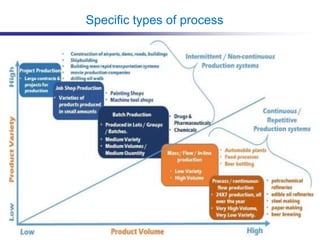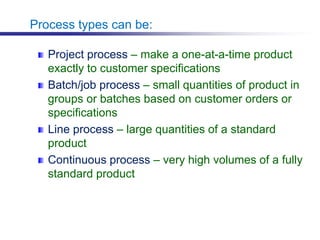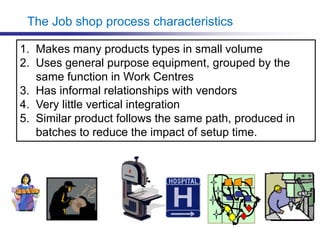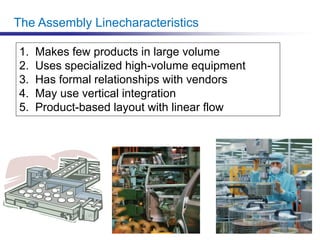om chapter 3.ppt
- 1. CHAPTER 3 PRODUCT DESIGN AND PROCESS SELECTION
- 2. Product design o Design is the conversion of ideas and concepts into a physical form o Design means the determination of shape, pattern, size, the functional aspect etc of the product which is offered to the customer in the form of the output of the company o Product design in its broadest sense includes the whole development of the product through all preliminary stages until the actual manufacturing begins
- 3. Product Design Product design – the process of defining all of the companies product characteristics The process of deciding on the unique characteristics of a company’s product & service offerings in terms of: o Appearance o Materials o Dimensions o Performance standards
- 4. Reasons for product or service design Economic o Low demand o Excessive warranty claims Social and demographic o Changing tastes o Aging population Political, liability, or legal o Safety issues o New regulations o Government changes
- 5. Reasons for product or service design Competitive o New products and services in the market o Promotions Cost or availability o Raw materials o Components o labor Technological o Components o Production processes
- 6. Objectives of product and service design Main focus o Customer satisfaction o Understand what the customer wants Secondary focus o Function of product/service o Cost/profit o Quality o Appearance o Ease of production/assembly o Ease of maintenance/service
- 7. The product design process
- 8. Step 1: Idea development Is the systematic search for new product ideas from • Employees • Market research • Customer survey • The organization's (R&D) department competitors • Suppliers Reverse engineering: buying a competitor’s product and disassembling it to analyze its design characteristics & how it was made Benchmarking: comparing and contrasting product and process characteristics against those of competitors
- 9. Step 2 - Product Screening Process to spot good ideas and drop poor ones as soon as possible. Many companies have systems for rating and screening ideas which estimate: o Fit with facility o Availability of labor skills & raw materials o Market Size and long-term potential o Product Price o Development Time & Costs o Manufacturing Costs o Return on sales o Break-even analysis etc.
- 10. Step 3: Preliminary Design General performance characteristics are translated into technical specifications Prototypes are built & tested (maybe offered for sale on a small scale)
- 11. Step Four : Final Design Specifications are set & then used to: Develop processing and service delivery instructions Guide equipment selection Outline jobs to be performed Negotiate contracts with suppliers and distributors
- 12. Issues in product and service design o Concurrent Engineering o Standardization o Mass customization o Recycling-Remanufacturing o Robust design o Computer-aided design (CAD) o Product reliability and range of operating conditions o Environmentally friendly design
- 13. Concurrent Engineering vs sequential design A design approach that uses multifunctional teams to simultaneously design the product & process Replaces a traditional ‘over-the-wall’ approach where one group does their part & then hands off the design to the next group
- 14. Standardization Extent to which there is an absence of variety in a product, service or process Design which enable a company to offer similar/identical products or product which satisfy the Mass Standardized products are immediately available to customers Example calculators, pen etc
- 15. Advantages of Standardization Fewer parts to deal with in inventory & manufacturing o Less costly to fill orders from inventory Reduced training costs and time More routine purchasing, handling, and inspection procedures Opportunities for long production runs, automation Possibility of perfecting designs and improving quality control procedures.
- 16. Disadvantages of Standardization Decreased variety results in less consumer appeal. Designs may be frozen with too many imperfections remaining. High cost of design changes increases resistance to improvements Standard systems are more vulnerable to failure
- 17. Mass Customization A strategy of producing standardized goods or services, but incorporating some degree of customization o Delayed differentiation o Modular design
- 18. Delayed Differentiation: Postponement tactic • Is a Producing but not quite completing a product/service until customer preferences/specifications are known
- 19. Modular design is a form of standardization in which component parts are subdivided into modules that are easily replaced or interchanged. o Products designed in easily segmented components o Adds flexibility to both production and marketing o Improved ability to satisfy customer requirements Modular Design
- 20. Reliability and normal operating conditions Reliability: The ability of a product, part, or system to perform its intended function under a prescribed set of conditions Failure: Situation in which a product, part, or system does not perform as intended Normal operating conditions: The set of conditions under which an item’s reliability is specified A regular car is not to be driven at 200 mph A bed is not to be used as a trampoline(sport)
- 21. Recycling: recovering materials for future use o Cost savings o Environment concerns o Environment regulations Remanufacturing: replacing worn out parts in used products Kodak cameras Recycling-Remanufacturing
- 22. Using computers to design products and prepare engineering documentation Shorter development cycles, improved accuracy, lower cost Information and designs can be deployed worldwide Computer Aided Design (CAD)
- 23. Computer technology used to develop a 3-D model of a product from the basic CAD data Allows people to ‘see’ the finished design before a physical model is built Virtual Reality Technology
- 24. Design that results in products or services that can function over a broad range of conditions In a design of a new system, any activity can be called robust design, if it causes the system… o To have longer life(higher reliability) o To have more consistent from use to use o To be more consistent from product to product o To perform consistently as temperature and other conditions Robust Design
- 25. • Designing a product from material that can be recycled, ease of repair, minimize packaging minimize material and energy used during manufacture, consumption and disposal Goals of environmentally friendly designs o Develop safe and environmentally sound products o Minimize waste of raw materials and energy o Reduce environmental liabilities o Increase cost-effectiveness of complying with environmental regulations o Be recognized as a good corporate citizen Environmentally Friendly Designs
- 26. Process and Process Selection Process: Any set of activities performed by an organization that takes inputs and transforms them into outputs ideally of greater value to the organization than the original inputs. Process selection refers to the strategic decision of selecting with which kind of production processes to have in the manufacturing plant. It has major implications for Capacity planning Layout of facilities Equipment Design of work systems
- 27. Process Selection: considerations Process selection is based on five considerations 1. Type of process; range from intermittent to continuous 2. Degree of vertical integration 3. Flexibility of resources 4. Mix between capital & human resources 5. Degree of customer contact
- 28. Process Selection types Two broad process classifications include Intermittent operations – produce a variety of products in lower volumes Repetitive operations – produce one or a few standardized products in high volume
- 29. Intermittent vs Repetitive Operations
- 30. Intermittent vs Repetitive Operations
- 31. Specific types of process
- 32. Process types can be: Project process – make a one-at-a-time product exactly to customer specifications Batch/job process – small quantities of product in groups or batches based on customer orders or specifications Line process – large quantities of a standard product Continuous process – very high volumes of a fully standard product
- 33. Project process characteristics 1. Makes a one-of-a-kind product (volume = 1) 2. Uses general purpose equipment 3. Has informal relationships with many vendors 4. Very little vertical integration 5. Flexible layout often with factors of production moving to job
- 34. The Job shop process characteristics 1. Makes many products types in small volume 2. Uses general purpose equipment, grouped by the same function in Work Centres 3. Has informal relationships with vendors 4. Very little vertical integration 5. Similar product follows the same path, produced in batches to reduce the impact of setup time.
- 35. The Large Batch process characteristics 1. Makes several families of products in moderate volume 2. Uses general purpose equipment 3. Little vertical integration 4. Hybrid layout with flow lines
- 36. The Assembly Linecharacteristics 1. Makes few products in large volume 2. Uses specialized high-volume equipment 3. Has formal relationships with vendors 4. May use vertical integration 5. Product-based layout with linear flow
- 37. Continuous Flow characteristics Continuous flow: An often automated process structure that converts raw materials into finished product in one continuous process. Highly standardized products, no variety Special-purpose equipment (no need for equipment flexibility) Skill of workers is low Examples: petroleum, steel, sugar, flour, and salt
- 38. Some examples(find the process type of each) Movie production Bakery Restaurant (non fast food) University Car repairing (car mechanic shop) Oil mining Producing office tools Veterinarian Project Batch Batch Batch Job shop Continuous Repetitive Job shop

